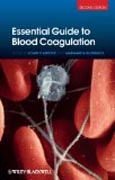
INDICE: List of contributors, x Preface, xii Abbreviations, xiii PART 1: GENERAL HEMOSTASIS 1 Schematic presentation of the hemostatic system, 3 Nils Egberg 2 Proposals for sampling instructions, 6 Margareta Blombäck and Nils Egberg Points to note prior to sampling, 6 Sampling time and patient preparation, 7 Referrals for coagulation analyses, 8 Sampling, 8 Technique, 9 For DNA investigation (genetic analyses), 10 3 Laboratory investigations, 11 Jovan P. Antovic, Liselotte Onelöv, and Nils Egberg Nomenclature, 11 Reference intervals for laboratory investigations, 13 Screening analyses, 13 Special analyses, 20 Markers of coagulation activation (hypercoagulation markers), 29 DNA analyses, 29 Global hemostatic assays and bedside methods, 31 Useful components in research studies, 32 Platelet–activating predictors, 35 PART 2: BLEEDING DISORDERS 4 Hereditary bleeding disorders, 41 Margareta Holmström and Lars Göran Lundberg General remarks about hemophilia A and B, 41 General remarks about von Willebrand disease, 42 Factor concentrates used for treatment of hemophilia A and B and VWD in Sweden in 2012, 43 Treatment strategy in severe forms of hemophilia and VWD, 44 Recommendations for desired initial plasma concentrations at different types of bleedings, 45 Surgery in patients with bleeding disorders, 47 Tooth extraction in a hemophilia patient, 47 Caution in patients with bleeding disorders, 48 Treatment principles for different types of bleeding disorders (severe, moderate, and milder forms of hemostatic defects), 49 Rare bleeding disorders, 51 Blood sampling in bleeding disorders, 54 Bleeding risk charts, 54 5 Critical bleeding, 56 Maria Bruzelius, Anna Ågren, and Hans Johnsson Introduction, 56 Defi nition of massive bleeding, 56 Transfusion coagulopathy, 56 Recommendations to obtain optimal hemostasis, 57 Choice of plasma, 58 Local procedures, 59 Additional treatment, 59 Fibrinogen concentrate, 59 Prothrombin–complex concentrate (PCC), 59 Recombinant factor VIIa, 59 Concentrates of other coagulation factors, 60 Cryoprecipitates, 60 Tranexamic acid, 60 Desmopressin, 60 Local hemostatic drugs, 60 Complicating factors, 61 Ongoing treatment with antiplatelet, and anticoagulant drugs, 61 6 Investigation of increased bleeding tendency, 62 Margareta Holmström and Lars Göran Lundberg Introduction, 62 Diagnosis, 62 Reasons for pathologic screening analyses and further actions, 64 Causes of thrombocytopenia, 64 Causes of prolonged activated partial thromboplastin time, 65 Causes of elevated PT(INR), 66 Investigation of bleeding tendency: practical aspects, 66 PART 3: THROMBOEMBOLIC DISORDERS 7 Venous thrombosis and pulmonary embolism, 71 Anders Carlsson Introduction, 71 Venous thrombosis, 72 Pulmonary embolism, 75 Primary prophylaxis against VTE, 91 8 Investigations of thromboembolic tendency, 94 Margareta Holmström Introduction, 94 Venous thromboembolism, 95 Arterial thromboembolism, 96 Disseminated intravascular coagulation, 96 9 Heart disease, 97 Håkan Wallen and Rickard Linder Ischemic heart disease, 97 Atrial fi brillation, 102 Cardiac valve prosthesis, 103 New oral anticoagulants in the treatment of heart disease, 104 10 Antiplatelet drug therapy and reversal of its effects, 105 Håkan Wallen, Hans Johnsson, and Bo–Michael Bellander Introduction, 105 ASA, 105 ADP (P2Y12) receptor antagonists, 106 GPIIb/IIIa receptor antagonists, 106 Phosphodiesterase inhibitors and other antiplatelet compounds, 108 Combined antithrombotic treatment, 108 Benefi t–risk assessment, 108 Platelet transfusion, 109 11 New oral anticoagulants: Focus on currently approved oral factor Xa and Thrombin inhibitors, 111 Rickard E. Malmström and Hans Johnsson Clinical pharmacology of NOACs, 111 Possibility of and need for therapeutic monitoring of NOACs, 114 Clinical aspects of NOACs, 114 Results of clinical trials, 116 Some characteristics of the individual NOACs, 118 Considerations to be taken when using NOACs in some emergency situations 12 Stroke and transient ischemic attack, 121 Nils Wahlgren and Mia von Euler Antithrombotic secondary stroke prevention, 121 Atrial fi brillation and TIA or stroke, 122 Thrombolysis in stroke, 122 Cerebral venous thrombosis and dissection of precerebral arteries, 123 Recurrent TIA, 124 Prophylactic treatment against DVT and PE, 124 13 Peripheral artery surgery, 125 Jesper Swedenborg Prophylaxis against reocclusion in peripheral vascular surgery or percutaneous transluminal angioplasty (PTA), 125 Peri– and postoperative treatment, 125 Thrombolysis in acute ischemia, 126 PART 4: SPECIAL HEMOSTASIS 14 Hemostasis in obstetrics and gynecology, 129 Katarina Bremme Introduction, 129 Thrombosis during pregnancy, 131 Heart disease: treatment of women with mechanical heart valve prostheses, 139 Thromboprophylaxis in obstetrics and gynecology, 140 Blood sampling in children of women with severe forms of thrombophilia, 148 Obstetric epidural/spinal analgesia (anesthesia), 148 Complications during pregnancy, 150 Postpartum bleeding, 155 Thromboprophylaxis in legal and spontaneous abortions, 156 Thromboprophylaxis in gynecologic surgery, 156 Investigation prior to artifi cial insemination (IVF), 160 Investigation in repeated miscarriages, 160 Investigation in menorrhagia (for treatment see Chapter 4), 161 15 Hemostasis in children, 162 Susanna Ranta and Pia Petrini Introduction, 162 Bleeding disorders in children, 166 Thromboembolic disorders in children, 172 16 Emergency conditions associated with coagulation: DIC, HIT and TTP/HUS, 182 Jovan P. Antovic and Margareta Holmström Disseminated intravascular coagulation, 182 Heparin–induced thrombocytopenia, 188 Thrombotic microangiopathies, 190 Index, 191
- ISBN: 978-1-118-28879-5
- Editorial: Wiley–Blackwell
- Encuadernacion: Rústica
- Páginas: 216
- Fecha Publicación: 12/04/2013
- Nº Volúmenes: 1
- Idioma: Inglés
